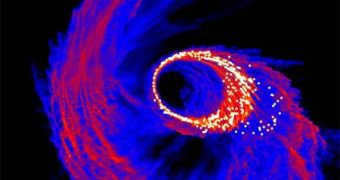Understanding exactly how supermassive black holes were formed is a long-standing dream that astronomers have, as these behemoths of the skies could be the key to unlocking some of the secrets of the Universe. But, although theories of how they came to be are many, none manages to explain all aspects of these complex formations. A new theory, called “dark gulping,” holds that extremely large black holes such as those found at the core of large galaxies, which can weigh up to a billion times more than the Sun, were actually formed by collapsing dark matter.
The hypothesis has been yielded by a computer model, which has hinted that the mysterious stuff may be the motor behind the formation of these supermassive monsters. Astronomers have thus far failed to discover any evidence that dark matter actually exists, as in to experimentally isolate it or through other scientific processes. Still, they know it's there simply because its effects on how galaxies interact are visible to an attentive observer. Several mathematical models have also revealed that dark matter must exist all around us, providing the Universe with a “frame” on which galaxies interact.
The new model that experts have used hypothesizes that a very large cloud of dark matter could have existed in a certain point of space. By interacting with large amounts of gas, this cloud may have begun to slowly form a central mass, which could have easily reached thermal instability. This part of the simulation is not exactly certain, because astronomers don't yet know the physical properties of dark matter. But, holding that the newly formed central mass cannot handle heat very well, the model shows that even a small disturbance could cause the central mass to collapse.
Thus, a supermassive black hole would be formed. It would, of course, be invisible at first, but, as it starts growing and cannibalizing on matter and gas around it, it could become visible over time. All the matter that would swirl around it would superheat and become luminous. The core and the event horizon would naturally remain obscured from direct observations, but then again so do all those of observed black holes.
“It's a viable, possible scenario. The model works, but it doesn't mean that nature behaves like that. We need more observational proof or disproof of this,” University College London's (UCL) Mullard Space Science Laboratory Astrophysicist Kinwah Wu, who has designed the new computer model with colleague Curtis Saxton, told Space.

 14 DAY TRIAL //
14 DAY TRIAL //